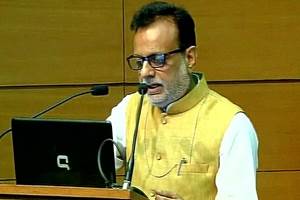While the Central government appears determined to rollout Goods and Services Tax in the country by April 1, 2017, there are still several hurdles that need to be tackled to meet the “stiff” deadline, according to Revenue secretary Hasmukh Adhiya. The three basic requirements for the implementation of ‘one India, one Tax’ are: Establishment of Legal Framework, setting up of proper IT infrastructure and “change management.” For the establishment of legal framework, the first step is ratification of the new law by at least 50% states of the country. Addressing a press conference today, Adhiya said the approval of 16 states would be obtained within 30 days.
After states’ approval, the GST Constitution Amendment Bill would go for Presidential assent, followed by approval and setting up of a GST Council by the Union Cabinet and the approval of the Model GST Bill. Adhiya said all bills should be introduced in the state assemblies and Parliament for approval during the winter session. The Revenue secretary said the government is ready with necessary IT infrastructure. As part of the “Change management”, for smooth rollout of uniform GST, Adhiya said about 60,000 officers across the country would be trained. “An outreach programme has already started and multiple Town Hall meetings will held in coming months to reach out to the business persons,” he said.
However, there are at least seven important hurdles still in the way for the implementation of GST across the country. Adhiya outlined them during the press conference. These are:
1.Calculation of revenue base of state and Centre: Adhiya said the present calculation by the CEA is based on the taxable base of state and Centre in 2013-14. Since then a lot of things have changed. New revenue base would have to be fixed for the rollout of GST.
2. Requirement of compensation: This can’t be done till GST Council decides rate structure, he said.
[related-post]
3. Fixing Tax level: “Everyone wants low taxes. It is always the ambition of government to lower taxes, but challenge lies in making a structure that is not obnoxious and which is actually meeting revenue requirement of the state and Centre,” Adhiya said while cautioning people against the newspaper reports assessing the impact of GST on several goods and services. “These are all premature calculations,” he said.
4. List of exemptions: States and Centre will have to agree to prepare the list of exemptions.
5. Forming consensus on Model GST Bill: Adhiya said there are 233 odd clauses and all of them need to be discussed by the GST Council. Moreover, 40,000 pages of suggestions have been received from public on the Model GST Bill. .
6. Threshold limits: Some states want low threshold limit of 10 lakh, some 25 lakhs. This need to be fixed along with the Compounding limits, Adhiya said.
7. Cross empowerment: This is necessary to mitigate the ill-effects of dual control. “We will have to divide work among ourselves (states and Centre) and cross empower each other,” he said.
